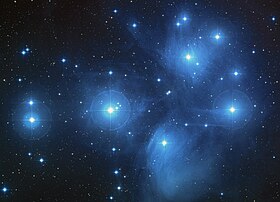दुला तारा
| प्रेक्षण तथ्य युग J2000 विषुव J2000 | |
|---|---|
| तारामंडल | वृष तारामंडल |
| दायाँ आरोहण | 03h 44m 52.53688s[1] |
| झुकाव | +24° 06′ 48.0112″[1] |
| सापेक्ष कांतिमान (V) | 3.70[2] |
| विशेषताएँ | |
| तारकीय श्रेणी | B6 IIIe[3] |
| U−B रंग सूचक | -0.40[4] |
| B−V रंग सूचक | -0.12[4] |
| खगोलमिति | |
| रेडियल वेग (Rv) | +10.9[5] किमी/सै |
| विशेष चाल (μ) | दाआ.: 20.84[1] मिआसै/वर्ष झु.: -46.06[1] मिआसै/वर्ष |
| लंबन (π) | 8.06 ± 0.25[1] मिआसै |
| दूरी | 400 ± 10 प्रव (124 ± 4 पार) |
| निरपेक्ष कांतिमान (MV) | −1.77[6] |
| विवरण | |
| त्रिज्या | 6.06[7] R☉ |
| सतही गुरुत्वाकर्षण (log g) | 3.412 ± 0.047[8] |
| तेजस्विता | 940[7] L☉ |
| तापमान | 13,484 ± 293[8] K |
| घूर्णन गति (v sin i) | 181[8] किमी/सै |
| अन्य नाम | |
| डेटाबेस संदर्भ | |
| सिम्बाद | data |
दुला या इलॅक्ट्रा (Electra), जिसका बायर नामांकन १७ टाओरी (17 Tau या 17 Tauri) है, वृष तारामंडल में स्थित एक तारा है। यह कृत्तिका तारागुच्छ का तीसरा सबसे तेजस्वी तारा है और इसका पृथ्वी से देखा गया औसत सापेक्ष कांतिमान (यानि चमक) का मैग्निट्यूड +३.७० है। दुला एक नीला-सफ़ेद बी-श्रेणी का दानव तारा है। इस तारे के कुछ लक्षण ऐसे हैं कि सम्भव है कि यह वास्तव में एक द्वितारा हो, लेकिन यह पूरी तरह स्थापित नहीं हुआ है।[9][3][10]
इन्हें भी देखें[संपादित करें]
सन्दर्भ[संपादित करें]
- ↑ अ आ इ ई उ Van Leeuwen, F. (2007). "Validation of the new Hipparcos reduction". Astronomy and Astrophysics. 474 (2): 653. arXiv:0708.1752. डीओआइ:10.1051/0004-6361:20078357. बिबकोड:2007A&A...474..653V.
- ↑ Ducati, J. R (2002). "VizieR Online Data Catalog: Catalogue of Stellar Photometry in Johnson's 11-color system". CDS/ADC Collection of Electronic Catalogues. 2237. बिबकोड:2002yCat.2237....0D.
- ↑ अ आ Grady, C. A.; Bjorkman, K. S.; Snow, T. P.; Sonneborn, George; Shore, Steven N.; Barker, Paul K. (April 1989). "Highly ionized stellar winds in Be stars. II - Winds in B6-B9.5e stars". Astrophysical Journal, Part 1. 339: 403–419. डीओआइ:10.1086/167306. बिबकोड:1989ApJ...339..403G.
- ↑ अ आ Johnson, H. L.; Iriarte, B.; Mitchell, R. I.; Wisniewskj, W. Z. (1966). "UBVRIJKL photometry of the bright stars". Communications of the Lunar and Planetary Laboratory. 4: 99–110. बिबकोड:1966CoLPL...4...99J.
- ↑ Pearce, J. A.; Hill, G. (1975). "A spectroscopic investigation of the Pleiades". Publications of the Dominion Astrophysical Observatory. 14 (14): 319–343. बिबकोड:1975PDAO...14..319P.
- ↑ Zhang, P; Liu, C. Q; Chen, P. S (2006). "Absolute Magnitudes of Be Stars Based on Hipparcos Parallaxes". Astrophysics and Space Science. 306 (3): 113. डीओआइ:10.1007/s10509-006-9173-1. बिबकोड:2006Ap&SS.306..113Z.
- ↑ अ आ Harmanec, P (2000). "Physical Properties and Evolutionary Stage of Be Stars". The Be Phenomenon in Early-Type Stars. 214: 13. बिबकोड:2000ASPC..214...13H.
- ↑ अ आ इ Frémat, Y.; Zorec, J.; Hubert, A.-M.; Floquet, M. (September 2005). "Effects of gravitational darkening on the determination of fundamental parameters in fast-rotating B-type stars". Astronomy and Astrophysics. 440 (1): 305–320. arXiv:astro-ph/0503381. डीओआइ:10.1051/0004-6361:20042229. बिबकोड:2005A&A...440..305F.
- ↑ "शुक्लयजुर्वेदमाध्यन्दिनीयसंहिता," योगेश्वर गुरु गंगेश्वर ट्रस्ट
- ↑ "Goddessess in Ancient India," Prithvi Kumar Agrawala, Abhinav Publications, 1984, ISBN 9780391029606, ... They form a group of seven stars which are named in the Taittiriya Brahmana as Amba, Dula, Nitatni, Abhrayanti, Meghayanti, Varshayanti and Chupunika ...

